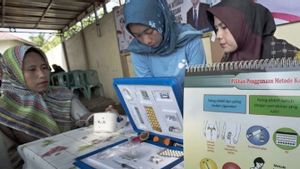JAKARTA The success of Algerian boxer Imane Khelf qualified for the women's 66kg class final at the 2024 Paris Olympics was accompanied by controversy. The results of tests conducted by the International Boxing Association (IBA) last year show that Khhelif has XY chromodynamics, which is generally owned by men.
The name Imane Khelf suddenly became the spotlight after he forced Angela Carini, an Italian boxer, to give up when the game had only been running for 46 seconds.
Starting from this incident, several people criticized the International Olympic Committee (IOC) for allowing Khhelif and Lin Yu-ting, two boxers who were previously said to have failed to fulfill genderworthiness by IBA.
Based on the results of the test conducted by IBA, Khelif was declared to have failed to meet the eligibility criteria to participate in women's competitions as regulated and listed in the IBA regulations.
According to the news circulating, XY chromodynamics was found both in Khelif and Yu-ting, although IBA could not commit to calling them biologically male.
However, the IOC doubted the accuracy of the test so that there was no reason to disqualify Imane Khelif and Lin Yu-ting.
Now, Imane Khelfif will fight in the fight for the gold medal after eliminating Janjaem Suwannapheng from Thailand. However, the controversy over his participation has not yet subsided.
Imane Khelif was deemed unfit to appear in the women's boxing bout by IBA at the 2023 World Championship which was held in New Delhi, India.
IBA said Khelif failed a gender eligibility test hours before the gold medal match against Yang Liu from China. Had filed an appeal to the Sports Arbitration Court, but Khhelif then canceled his appeal.
In the midst of the current situation, IBA Chief Executive Chris Roberts explained that his party could not reveal the results of the Khelif and Yu-ting gender eligibility tests, but reiterated the reasons why the Algerian boxer was prohibited from appearing in last year's World Championship final.
"The results of the chromodynamic test show that the two boxers did not meet the requirements," Roberts said at a press conference, reported by Reuters.
SEE ALSO:
"In its regulation, IBA insists the boxer will compete against the same sex boxer, which means women vs women and men vs men in accordance with the definition of this regulation."
IBA defines women, girls or girls as "individuals with XX chromodynamics" and boys, boys or boys as "individuals with XY chromodynamics".
IBA denies the WHhelif testosterone levels have been tested. However, in an interview with BBC, Roberts said XY's chromodynamics was found in the both cases', referring to Imane Khelif and Lin Yu-ting.
Roberts added that there are different factors involved in it and therefore, the agency cannot commit to calling Khelif a biological man.
Apart from the cases of Imane Khelif and Lin Yu-ting, there are indeed rare genetic conditions where women have XY chromodynamics. They have normal female reproductive organs, including the uterus, tuba channel, and vagina.
The medical term for this case is Dwyer syndrome. Quoting Feedline Plus, Dwyer syndrome is a condition that affects the development of sex.
Lawyer syndrome is classified as a sex development disorder or disorder of sex development (DSD), which includes any abnormalities where the development of chromodynamics, gonad, or sex anatomy is abnormal.
Kromosom contains genetic instructions on how the body develops and functions. People usually have 46 chromosomes in each cell. Two of the 46 chromosomes, known as X and Y, are called sex chromosomes because it helps determine whether one will develop a male or female reproductive structure.
Girls and girls usually have two X-chromodynamics, while boys and boys usually have one X-chromodynamic and one Y-chromodynamics, explains MEDline Plus.
In Dwyer syndrome, individuals have one chromodynamic X and one Y in each cell, a pattern that is usually found in adult boys and boys, but they have a female reproductive structure.
Despite having XY chromodynamics, women with Dwyer syndrome have genitals and a functioning female structure including vaginas, uteruses, and Tuba channels.
There is no definite explanation as to what caused Dwyer's syndrome. But according to existing research, experts think this condition is caused by the gene mutation responsible for gender differentiation.
Simply put, any changes to the genes that play a role in the development of the testes can lead to Dwyer syndrome.
The English, Chinese, Japanese, Arabic, and French versions are automatically generated by the AI. So there may still be inaccuracies in translating, please always see Indonesian as our main language. (system supported by DigitalSiber.id)














